Why Is A Golf Course Called The Links
Why Is A Golf Course Called The Links? A golf course is called “the links” because of the special land where golf first began. The word “links” comes from the old English word “hlinc,” which means a hill or ridge.
Long ago in Scotland, people played golf on coastal land between the sea and the farmland. This land had sandy soil, small hills, and few trees. It was called “linksland.”
Since it wasn’t good for farming, it became the perfect place to play golf. These links courses were dry and firm, so the ball rolled more than it flew.
This made the game harder and more fun. Famous places like St. Andrews in Scotland are called true links golf courses because they still use this natural style.
These courses weren’t designed like today’s fancy parkland courses. Instead, they were shaped by nature, not machines. The grass was short and firm, and the wind was wild.
It forced golfers, like me, to think about every shot. On a true links course, the ball bounces, rolls, and reacts to the ground more than the air. That’s the real challenge.
What Does the Word “Links” Mean in Golf and Why Is A Golf Course Called The Links
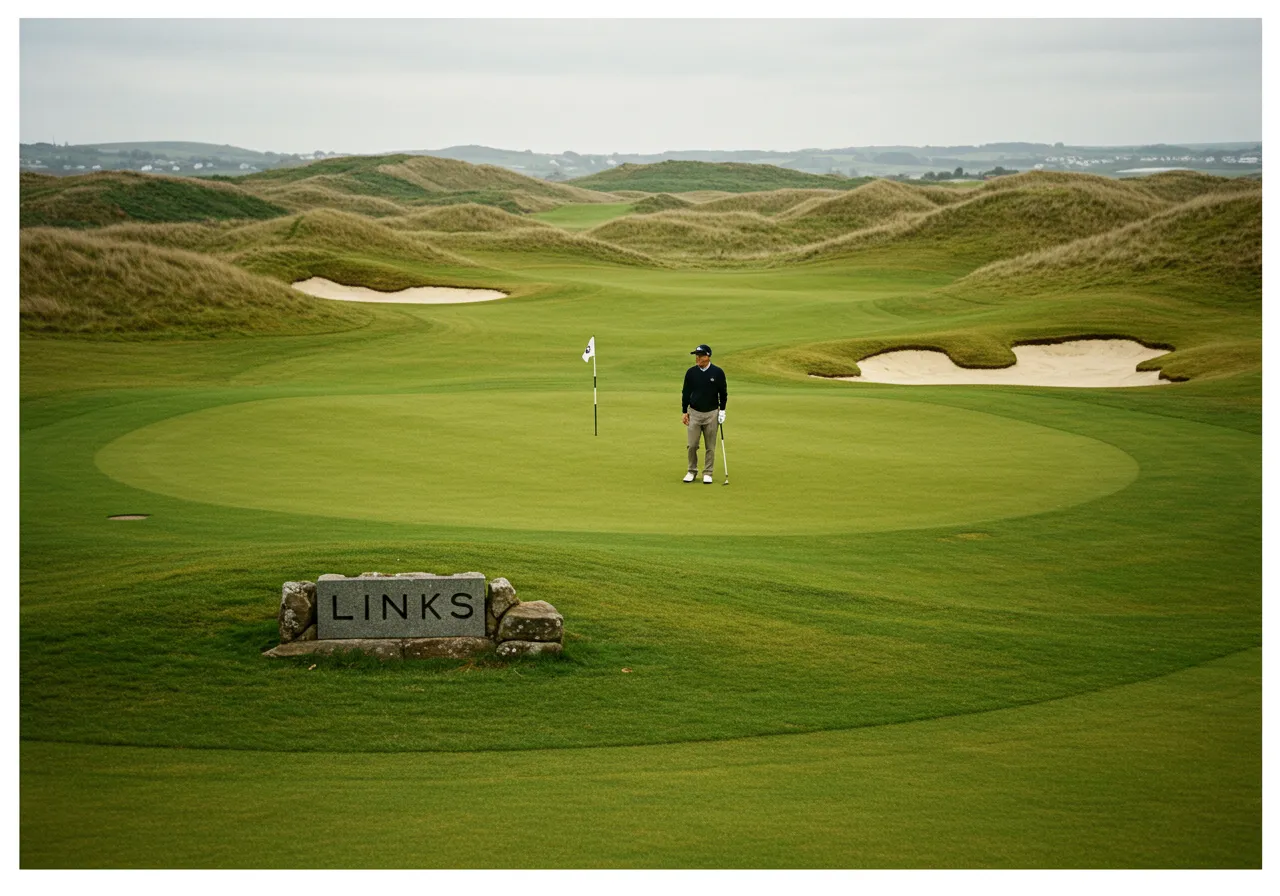
The word “links” comes from the Old English word “hlinc,” which means a ridge or rising ground.
It was used to describe the bumpy, coastal land found along the shores of Scotland, where golf was first played hundreds of years ago. This kind of land was naturally shaped by wind, rain, and sea over time.
What Is Linksland and Why Was It Chosen for Golf
In Scotland, linksland referred to the strip of land between the sea and the farmland. This land had sandy soil, rolling hills, and almost no trees.
It couldn’t be used for farming because the ground was too poor and dry. But it was perfect for golf.
Early golfers loved this kind of land because it had firm turf, natural slopes, and open space. They didn’t have to build much.
They just used what was already there. That’s how the first courses were made—by walking and hitting balls through the natural terrain.
How the Term “Links” Became the Name for Golf Courses
When golfers played on this coastal land, they started calling it simply “the links.” Over time, the name stuck.
Today, when someone says “let’s hit the links,” they’re talking about playing golf, even if the course isn’t a true links course.
But the original meaning still matters. A true links course must be built on coastal land with sandy soil, natural hills, and few trees.
It’s not just a name, it’s a type of course with deep roots in Scottish golf history.
Why Linksland Was Ideal for the Origins of Golf
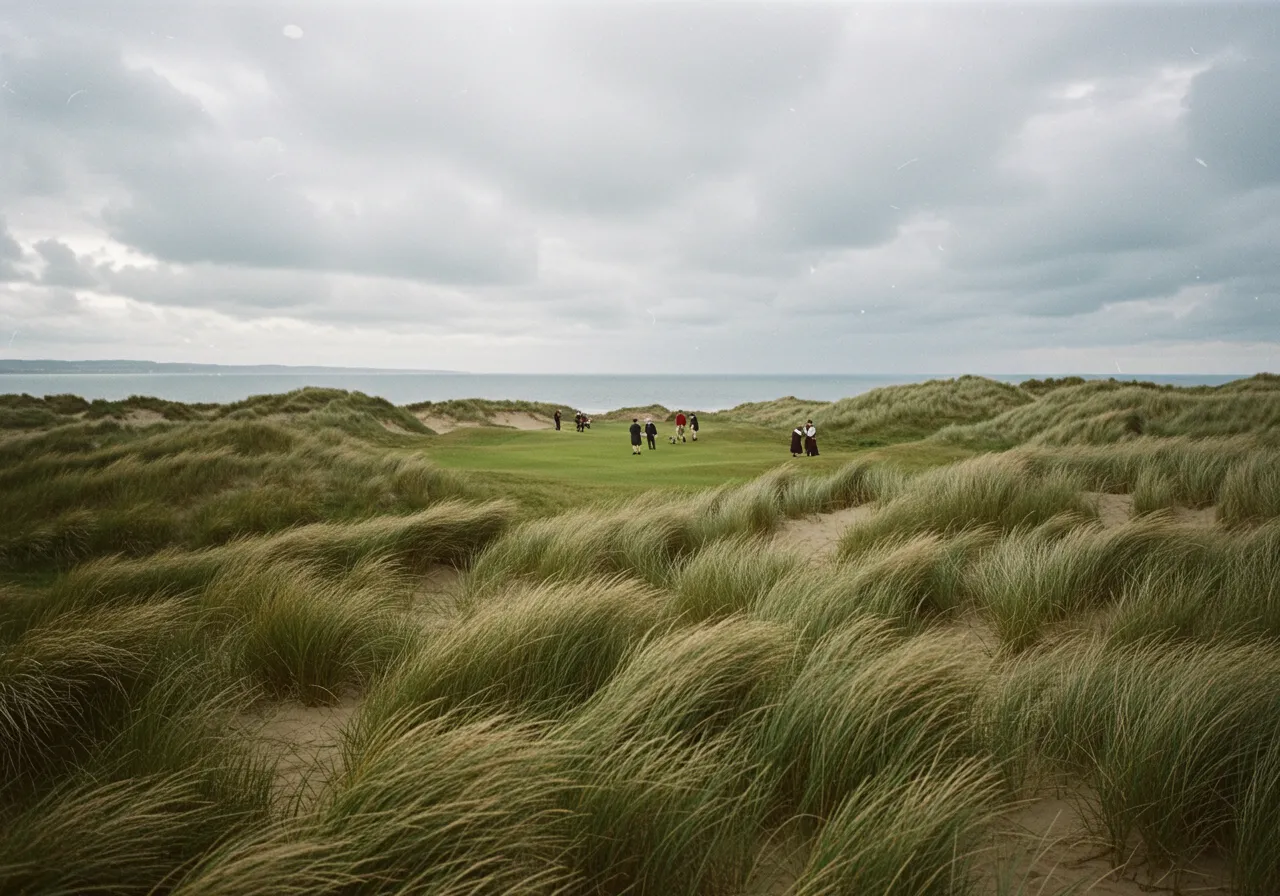
Back then, there were no machines to flatten land or build fancy greens. The natural features of Linksland, like the firm ground, sea wind, and bunkers formed by sheep, made every shot a challenge.
That’s how golf became a game of skill, creativity, and control, instead of just power.
Playing golf on the links was about working with nature, not against it. This connection between the land and the game is part of what makes links golf so special, even today.
Comparison Table: True Links Course vs. Modern Parkland Course
| Feature | True Links Course | Modern Parkland Course |
| Location | Coastal (near sea) | Inland (parks, woodlands) |
| Soil Type | Sandy, well-draining | Rich, loamy, more compact |
| Grass Type | Bentgrass, Fescue | Ryegrass, Poa Annua, Kentucky Bluegrass |
| Tree Coverage | Few or none | Many trees and shade areas |
| Terrain | Natural, uneven, with dunes | Manicured, flat, or gently rolling |
| Wind Conditions | Frequently windy | Usually protected from the wind |
| Water Hazards | Minimal, usually natural | Often, man-made lakes and ponds |
| Bunker Type | Deep “pot bunkers,” small and rugged | Wide, shallow bunkers with smooth edges |
| Course Design | Shaped by land (minimal earth-moving) | Designed and sculpted by architects |
| Shot Style | Low shots, bump-and-run | High, soft landings with target play |
| Famous Examples | St. Andrews (Scotland), Royal Dornoch | Augusta National (USA), Wentworth Club (UK) |
Note: This table highlights the key differences between true links courses and modern parkland golf courses, using real examples and course features.
What Defines a True Links Golf Course
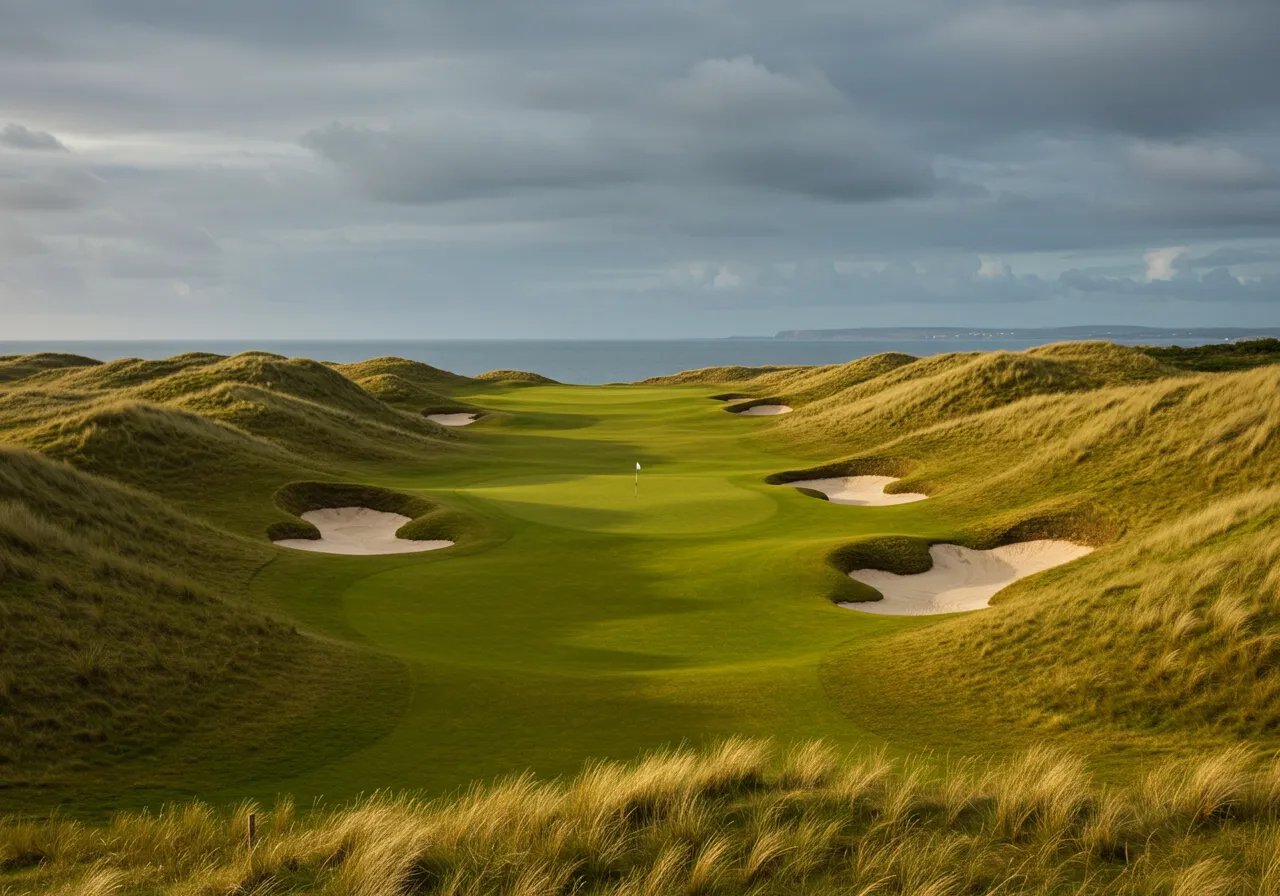
Many people think that any golf course near the sea is a links course, but that’s not true.
As a golf pro who’s played across the world, I can tell you: a true links course is more than just a beachside view.
Links courses are shaped by nature, not machines. They come from ancient coastal land, where the ground is sandy, the weather is tough, and the design follows the land’s natural shape.
These features go back to the very beginning of golf in Scotland.
Main Features That Make a Golf Course a True Links Course
Why Sandy Soil and Firm Turf Matter in Links Golf
On a real links course, the ground is made of sandy soil, not clay or dirt. This helps water drain fast, even after heavy rain.
That’s why links turf is firm and dry, perfect for the bump-and-run style of golf. Balls don’t just stop; they roll, bounce, and move with the ground.
As a player, you have to aim low and think smart. You can’t always hit high shots. That’s part of the link challenge.
How Undulating Ground Shapes Every Shot You Take
Links courses aren’t flat or smooth. The land has natural hills, dips, and curves, called undulations.
Bulldozers didn’t make these bumps; they were formed by wind and weather over hundreds of years.
That means no two lies are the same. One moment you’re on a hilltop, the next you’re in a dip. It makes every round feel different and exciting.
Why Links Courses Have No Trees and So Much Wind
On most links courses, you won’t see many trees. That’s because the salty sea air and strong winds make it hard for trees to grow. Instead, the wind becomes your biggest challenge.
You learn to control your ball in the wind, keep it low, and let the breeze do some of the work, or fight against it. Wind is not just a weather report here. It’s part of the course design.
What Makes Links Course Bunkers So Deep and Dangerous
The bunkers on a links course are called pot bunkers. They’re small, very deep, and have steep, sometimes vertical walls.
Many of these were created naturally, animals like sheep dug into the ground for shelter, and those spots later became hazards.
Unlike wide, shallow bunkers on modern courses, pot bunkers are tight and tricky. If you land in one, you might need to hit sideways just to get out.
How Fescue Grass and Gorse Bushes Define the Rough In Links Golf

You’ll also notice that the grass is different on a links course. It’s not soft or lush. It’s made of native fescue grass, long, thin, and wispy. When you hit it, it’s hard to control your ball.
Some courses also have gorse bushes, which are sharp, spiky, and dense. Hit your ball in there, and you might not see it again.
These natural plants make shot-making even harder and force you to play smart.
Table: Key Features That Define a True Links Golf Course
| Feature | True Links Course | Non-Links (Parkland/Modern) Course |
| Soil Type | Sandy, fast-draining | Clay or loamy, holds moisture |
| Turf Condition | Firm, dry, promotes roll | Soft, lush, designed for soft landings |
| Terrain Style | Natural humps, hollows, dunes | Man-made contours, mostly flat or sculpted |
| Tree Coverage | Very few or none | Many trees, shaded fairways |
| Wind Influence | A major factor, open to sea winds | Often sheltered from the wind |
| Bunker Type | Deep, steep-walled pot bunkers | Wide, shallow sand traps |
| Grass Type | Native fescue, firm and wispy | Ryegrass, Poa Annua, Kentucky Bluegrass |
| Hazards | Natural rough, gorse bushes, pot bunkers | Water hazards, trees, and landscaped rough |
| Shot Style Required | Low shots, bump-and-run strategy | High shots, aerial target-style approach |
| Course Origins | Evolved from natural Scottish coastal terrain | Designed and built using modern architecture |
| Famous Examples | St. Andrews, Royal Troon, Royal Dornoch | Augusta National, Torrey Pines, Valhalla |
Note: This table explains the physical, design, and gameplay differences between true links courses and typical inland or parkland courses.
A Tale of Two Terrains – Links Golf Courses vs. Regular Parkland Courses
As a golf pro, I’ve played both types of courses around the world, and let me tell you, a links course and a regular inland course (often called a parkland course) feel like two completely different games.
Many golfers don’t know the difference at first, but once you walk both types of fairways, you’ll never forget it. Here’s how to understand it in a simple way.
What Is the Difference Between a Links Course and a Regular Golf Course
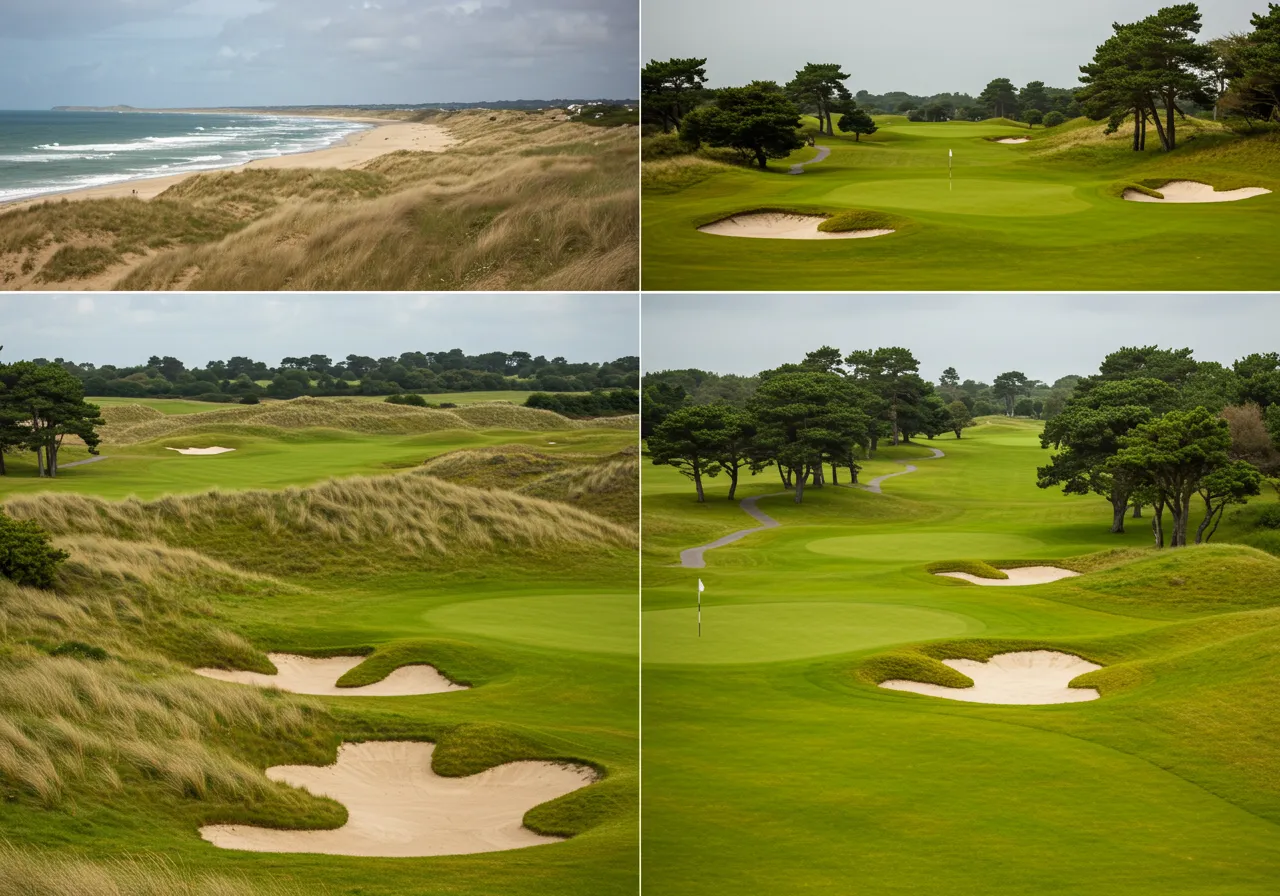
A links course is built on coastal land, using natural features like dunes, wind, and firm ground.
A parkland course is often built inland, with soft turf, lots of trees, and carefully designed layouts.
Let’s break it down clearly:
Table: Links vs. Parkland Golf Courses – What Makes Them Different
| Feature | Links Course (True Links) | Parkland Course (Regular/Inland) |
| Location | Coastal, near the sea | Inland, often in wooded areas |
| Soil Type | Sandy, drains quickly | Clay or loam holds water |
| Playing Surface | Firm, dry, fast-rolling turf | Soft, lush, green turf |
| Terrain | Natural humps, dunes, no flat areas | Man-made, smooth, and well-planned |
| Trees | Very few or none | Many trees line the fairways |
| Main Hazards | Wind, deep pot bunkers, gorse bushes | Water hazards, trees, and shaped bunkers |
| Grass Type | Fescue, bentgrass | Ryegrass, Poa Annua, Kentucky Bluegrass |
| Shot Style | Low shots, bump-and-run style | High, soft-landing shots |
| Wind Conditions | Wind plays a major role | Usually protected from the wind |
| Course Design | Shaped by nature (no bulldozers) | Designed by golf architects |
| Famous Example | St. Andrews Old Course (Scotland) | Augusta National Golf Club (USA) |
Why the Playing Style Feels So Different on Each Type of Golf Course
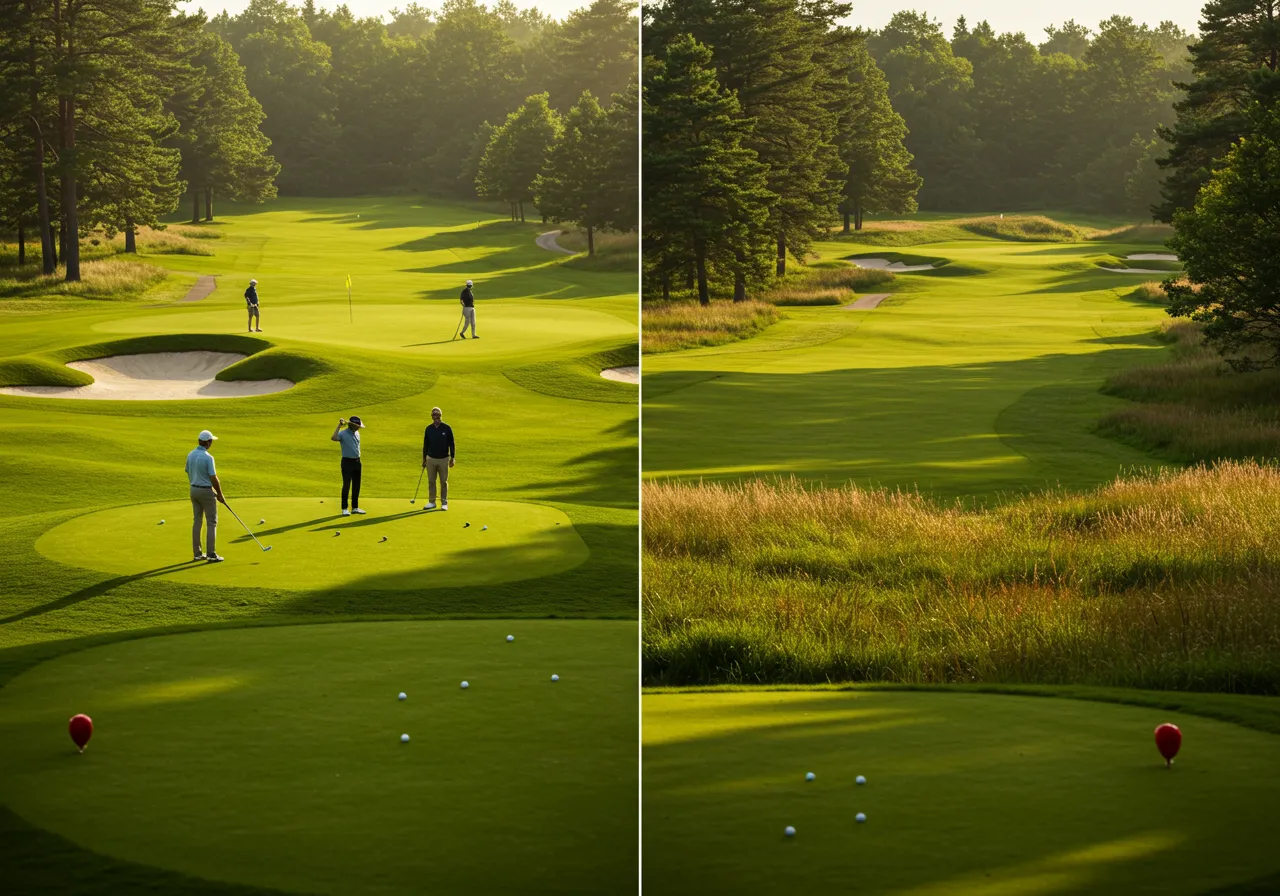
On a links course, the ball runs fast, and the wind can push it off line. You have to play low shots, read the ground, and use imagination.
On a parkland course, everything feels softer and calmer. You’ll need high shots to land softly on the greens, and you’ll likely aim around trees and water hazards instead of sand dunes and wind.
This difference is why playing in The Open Championship feels so different from The Masters, even though they’re both major tournaments.
The style, the challenge, and the environment are completely different.
FAQs
What does “links” mean in golf and why is it called that?
Links come from the Old English word hlinc, meaning ridge or rising ground. It describes the sandy, uneven land between the sea and farmland in Scotland, called linksland.
This coastal terrain offered firm turf, sand dunes, and wind, making it the perfect natural setting for early golf courses, hence the name links golf course.
What defines a true links golf course?
A true links course has five key features:
- Coastal terrain with sandy soil
- Undulating ground—natural hills and dunes
- Firm turf that makes the ball run along the fairway
- Few or no trees, so the wind plays a major part
- Deep pot bunkers and rough covered with native fescue grass
Why do people say “hit the links” when they go golfing?
Originally, “hit the links” meant playing golf on linksland, the natural coastal area in Scotland where the sport began.
Nowadays, it’s a friendly way to say “go play golf”; even if you’re on an inland or parkland course, it’s a fun nod to golf’s Scottish roots.
Why are links golf courses harder than regular courses?
Links golf is tougher because:
- Windy coastal conditions push your shots off track
- Firm turf makes the ball roll far, so you need to play bump-and-run shots
- Pot bunkers are deep and tricky to escape
- The rough has sharp, native grass like fescue, and even gorse bushes
Is the Old Course at St Andrews a true links golf course?
Yes! The Old Course at St Andrews, over 600 years old, is the perfect example of a true links course.
It has sandy soil, rolling dunes, firm turf, wild wind, pot bunkers, and no trees, all wrapped into the famous “Home of Golf”.
How many true links courses are there in the world?
There are approximately 247 true links courses worldwide, most of which are located in the UK and Ireland.
Scotland alone has around 85, Ireland about 58, and England 53. A few rare links courses exist in Europe, Australia, New Zealand, and the US, but they are much less common.
Can a golf course by the sea be called a links course?
Not always. A seaside course must also have sandy, well-draining soil, natural dunes, firm turf, pot bunkers, and windy, treeless conditions.
Just being near the ocean isn’t enough, it must have the true links architecture and terrain to be called a real links golf course
Conclusion
A links golf course is more than just grass by the sea; it’s built on sandy, coastal terrain with undulating dunes, firm turf, pot bunkers, and wind.
The word “links” comes from the Old English hlinc, meaning ridge or rising ground, and points back to the sand dunes of Scotland, where golf was first played in the 15th century.
That kind of land made golf a game of smart thinking and skill, not just hitting the ball hard. Players had to use low shots, let the ball roll, and deal with the wind.
Even today, courses like St. Andrews Old Course, the famous “Home of Golf”, still let people play golf the way it started: simple, natural, and challenging.
So next time someone says “let’s hit the links,” remember it’s not just slang, it’s a connection to golf’s origins and its most challenging, authentic test.
The World’s Best Links Golf Course
Posts References:
What are the Origins of Links Golf Courses
Why are golf courses called golf ‘links’